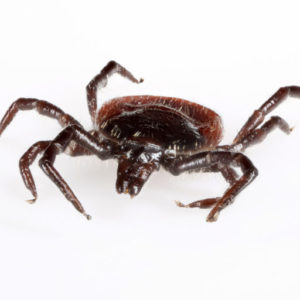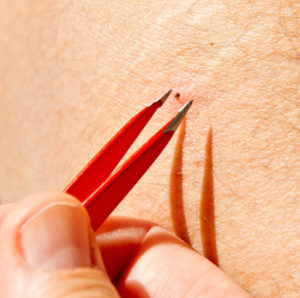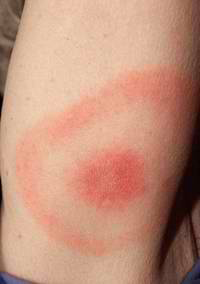It’s important to remove a tick from your body quickly – but do not panic.
Living in Central Massachusetts, you have likely found a tick on your body at one time or another. A typical scenario when someone finds a tick on their body is to freak out. Don’t freak – but DO act fast.

Tick Bite Treatment Protocol
Remove The Tick: If the tick is attached to your skin, remove it immediately. Wearing gloves, grasp the tick with clean tweezers as close to the skin as possible to remove the head and mouthparts. If some mouthparts remain, do not try to remove them, as your body will expel them naturally. Pull the tick straight out gently and steadily. Do not twist it. Do not try to remove a tick with a hot match or petroleum jelly or peppermint oil. This could cause the tick to regurgitate infected fluids into the wound. Save the tick in a container of alcohol to show the doctor.
Also read: Are fleas or ticks more dangerous?
Cleanse and Protect the Area: Wash your hands and clean the bite area with warm water and gentle soap. Next, apply alcohol to the bite wound to prevent infection.
See a Health Care Provider: See your medical internist or health care provider immediately if the tick has burrowed into your skin or if the head, mouthparts, or other tick remains cannot be removed.
Also see a doctor if you have found a tick on you body and…

You think it might be a deer tick, which is especially prevalent in the Northeast United States. According to The Centers for Disease Control, these disease-carrying parasites can be found in both inland and coastal areas, including off-shore islands, such as Nantucket and Martha’s Vineyard in Massachusetts; Block Island in Rhode Island; and Shelter Island, Fire Island, and eastern Long Island in neighboring New York state. Your doctor may prescribe a single dose of an antibiotic to help prevent Lyme disease.
You develop flu-like symptoms including fever, headache, nausea, vomiting, and muscle aches, or a rash within one month after the bite. Take the tick to the health care provider’s office or the hospital if possible.
The bite area develops a lesion within 30 days. A sign of Lyme disease infection is a “bullseye” rash in which the center becomes clearer as the redness moves outward in a circular pattern.
There are signs of infection such as redness, warmth, or inflammation.
Follow Up To Ensure Your Well Being: Your health care provider may prescribe antibiotics if you have symptoms of Lyme disease, Rocky Mountain spotted fever, or another tick-borne disease.
Year-Round Tick Control Is Your Best Bet For Total Protection From Tick Bites
 Enlist help from a reputable tick control company, you’ll have access to year-round protection for ticks. And, if you’re not aware, ticks are definitely a year-round problem in our area. The brown dog tick is able to complete its entire life cycle indoors. f this tick gets into your home during the summer or fall, you could have a full-blown infestation in the winter. It’s good to know that expert help is just a call away. Ticks can also enter your home during the colder months of the year by hitching a ride on rodents. Mice and rats carry ticks and spread them to unexpected locations. Tick treatments will reduce ticks around your perimeter and reduce the exposure of mice and rats to ticks on your property and, through the winter, the addition of rodent control can keep rodents out.
Enlist help from a reputable tick control company, you’ll have access to year-round protection for ticks. And, if you’re not aware, ticks are definitely a year-round problem in our area. The brown dog tick is able to complete its entire life cycle indoors. f this tick gets into your home during the summer or fall, you could have a full-blown infestation in the winter. It’s good to know that expert help is just a call away. Ticks can also enter your home during the colder months of the year by hitching a ride on rodents. Mice and rats carry ticks and spread them to unexpected locations. Tick treatments will reduce ticks around your perimeter and reduce the exposure of mice and rats to ticks on your property and, through the winter, the addition of rodent control can keep rodents out.



